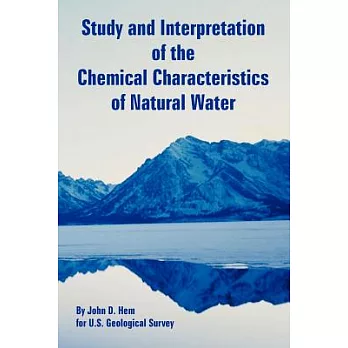The chemical composition of natural water is derived from many different sources of solutes, including gases and aerosols from the atmosphere, weathering and erosion of rocks and soil, solution or precipitation reactions occurring below the land surface, and cultural effects resulting from activities of man. Some of the processes of solution or precipitation of minerals can be closely evaluated by means of principles of chemical equilibrium including the law of mass action and the Nernst equation. Other processes are irreversible and require consideration of reaction mechanisms and rates. The chemical composition of the crustal rocks of the earth and the composition of the ocean and the atmosphere are significant in evaluating sources of solutes in natural fresh water. The ways in which solutes are taken up or precipitated and the amounts present in solution are influenced by many environmental factors, especially climate, structure and position of rock strata, and biochemical effects associated with life cycles of plants and animals, both microscopic and macroscopic. Taken all together and in application with the further influence of the general circulation of all water in the hydrologic cycle, the chemical principles and environmental factors form a basis for the developing science of natural-water chemistry. Fundamental data used in the determination of water quality are obtained by the chemical analysis of water samples in the laboratory or onsite sensing of chemical properties in the field. Sampling is complicated by changes in composition of moving water and the effects of particulate suspended material. Most of the constituents determined are reported in gravimetric units, usually milligrams per liter or milliequivalents per liter. More than 60 constituents and properties are included in water analyses frequently enough to provide a basis for consideration of the sources from which each is generally derived, most probable forms of elements and ions in solution, solubility controls, expected concentration ranges and other chemical factors. Concentrations of elements that are commonly present in amounts less than a few tens of micrograms per liter cannot always be easily explained, but present information suggests many are controlled by solubility of hydroxide or carbonate or by sorption on solid particles. Chemical analyses may be grouped and statistically evaluated by averages, frequency distributions, or ion correlations to summarize large volumes of data. Graphing of analyses or of groups of analyses aids in showing chemical relationships among waters, probable sources of solutes, areal water-quality regimen, and water-resources evaluation. Graphs may show water type based on chemical composition, relationships among ions, or groups of ions in individual waters or many waters considered simultaneously. The relationships of water quality to hydrologic parameters, such as stream discharge rate or ground-water flow patterns, can be shown by mathematical equations, graphs, and maps. About 75 water analyses selected from the literature are tabulated to illustrate the relationships described, and some of these, along with many others that are not tabulated, are also utilized in demonstrating graphing and mapping techniques. Relationships of water composition to source rock type are illustrated by graphs of some of the tabulated analyses. Activities of man may modify water composition extensively through direct effects of pollution and indirect results of water development, such as intrusion of sea water in ground-water aquifiers. Water-quality standards for domestic, agricultural, and industrial use have been published by various agencies. Irrigation project requirements for water quality are particularly intricate. Fundamental knowledge of processes that control natural water composition is required for rational management of water quality.



 天天爆殺
天天爆殺  今日66折
今日66折 
























 博客來
博客來 博客來
博客來 博客來
博客來 博客來
博客來 博客來
博客來